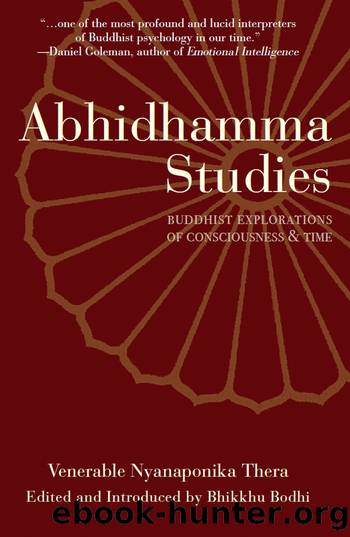Abhidhamma Studies: Buddhist Explorations of Consciousness and Time by Nyanaponika

Author:Nyanaponika [Nyanaponika]
Language: eng
Format: epub
Tags: Religion, buddhism, Theravada, philosophy, Buddhist, Metaphysics, Mind & Body
ISBN: 9780861719181
Google: VXT7ZuLq0qoC
Publisher: Simon and Schuster
Published: 2012-11-12T00:08:19.532523+00:00
5. THE POWERS (bala, F24â30)
We have already remarked how the faculty of controlling presupposes a certain intensity of the mental factors concerned. We have seen how the function of intensifying is performed by the factors of absorption, and we have given examples of this in the particular case of the five spiritual faculties. The resultant intensity of those faculties is described and emphasized by repeating them in the list under the name of powers (bala).
The commentarial explanation (e.g., at Asl 124) says that the five factors corresponding to the spiritual faculties, and also the two additional constituents of this group, namely moral shame (hiri) and moral dread (ottappa), are called âpowersâ because they are âunshakableâ (akampiya) by their opposites; thus, for example, faith is not shaken by faithlessness (or unbelief). But in view of the fact that all these psychological statements refer in the first instance only to the duration of a single moment of consciousness, and since the âcontrolâ or âpowerâ won at that moment may well be lost in the next, it is better and less ambitious to render the word akampiya by âfirm.â So we may say that these seven factors are powers of firm preponderance. In the case of the five spiritual faculties, this signifies that the âcontrolâ exercised by them has gained a degree of stability.
It should be borne in mind that the five spiritual faculties and the five spiritual powers are simply two different aspects of the same qualities. How their nature is basically one, though their functions are different, was illustrated by the Buddha in the following simile: If there was a river flowing eastward with an island in the midst of it, the stream could be regarded as one when seen in its flow at the eastern and western sides of the island, but as two from the islandâs northern and southern sides. In the same way should the identity of the spiritual faculties and powers be understood (SN V 219â20).
When the function of these five powers is considered within a single moment, merely the somewhat self-evident fact is implied that in order to be in existence at all the corresponding five spiritual faculties must necessarily have been able to âoverpowerâ the opposing tendencies for the duration of that moment (their indriya-quality), and that by doing so they have achieved a certain âfirmnessâ (their bala-quality) for that period. The powers can be said to be present to that extent even when the faculties are relatively weak. But this does not exhaust the power-aspect. They are not only those limited actualities of the brief present moment but also potentialities for the future. We have already mentioned that the enumeration of a factor under different group headings points to potential connections with such other constituents of these groups as are not included in the given state of consciousness; in other words, new perspectives are opened up beyond the present moment. In that case, the potentialities refer to an increasing width of relations with other wholesome factors.
Download
This site does not store any files on its server. We only index and link to content provided by other sites. Please contact the content providers to delete copyright contents if any and email us, we'll remove relevant links or contents immediately.
| Anthropology | Archaeology |
| Philosophy | Politics & Government |
| Social Sciences | Sociology |
| Women's Studies |
Born to Run: by Christopher McDougall(6903)
The Leavers by Lisa Ko(6810)
iGen by Jean M. Twenge(5171)
Sapiens by Yuval Noah Harari(5131)
The Kite Runner by Khaled Hosseini(4962)
Spare by Prince Harry The Duke of Sussex(4806)
Bullshit Jobs by David Graeber(3851)
Machine Learning at Scale with H2O by Gregory Keys | David Whiting(3666)
Never by Ken Follett(3550)
Livewired by David Eagleman(3540)
Goodbye Paradise(3462)
Fairy Tale by Stephen King(2976)
A Dictionary of Sociology by Unknown(2864)
Harry Potter 4 - Harry Potter and The Goblet of Fire by J.K.Rowling(2818)
The Social Psychology of Inequality by Unknown(2776)
The Club by A.L. Brooks(2758)
People of the Earth: An Introduction to World Prehistory by Dr. Brian Fagan & Nadia Durrani(2622)
0041152001443424520 .pdf by Unknown(2613)
Will by Will Smith(2595)
